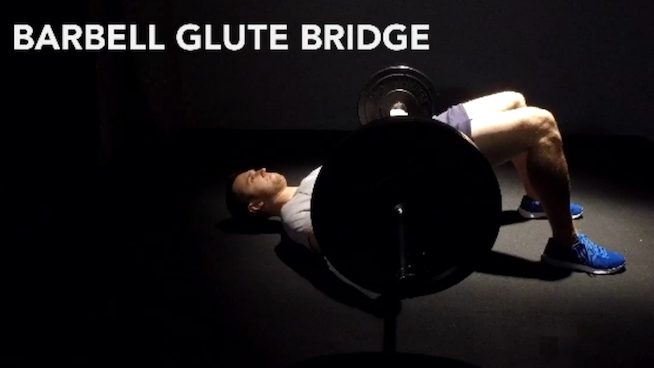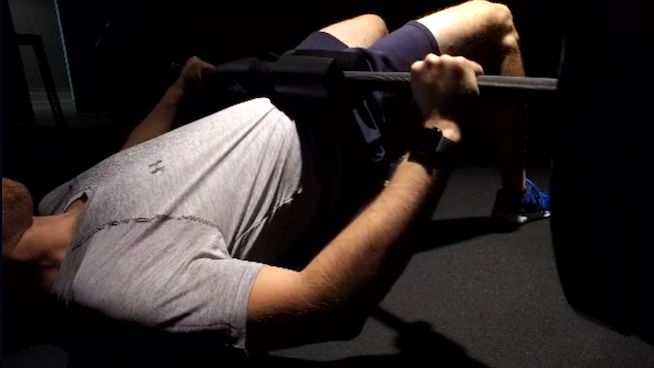Master the Barbell Glute Bridge
The Barbell Glute Bridge is a lower-body exercise that develops your glute muscles. It’s a variation of the bodyweight Glute Bridge with a barbell placed over your hips, which allows you to perform the exercise with heavy weight.
What is a Glute Bridge? (And Why Should I Do It?)

Here’s how to do it:
Action: Drive your hips up until you form a straight line with your body between your shoulders and knees. Squeeze your glutes at the top of each rep. Lower with control and repeat.
Coaching Points:
-
Load the barbell with at least one 45-pound plate or a bumper plate of any weight on each side so you have enough room to slide the bar over your legs.
-
Use a barbell pad or place an Airex pad between your hips and the bar to avoid discomfort.
-
Your shins should be vertical or have a slightly forward angle, and your toes should be straight or slightly angled outward. Try each position and find what works best for you.
-
Do not allow your knees to fall inward.
-
Flatten your lower back against the ground and tighten your core to protect your spine. If you feel your lower back moving during the exercise, you’re doing it wrong.
-
If you have tight hips, you may not be able to create a straight line with your body at the top of the bridge. That’s OK. Only drive up as far as your range of motion allows, again to protect your spine.
This exercise is based on the Bodyweight Glute Bridge, which is frequently performed during dynamic warm-ups to activate the glutes and during general fitness workouts to improve glute aesthetics.
The glutes are the largest and most powerful muscles in the body, primarily responsible for extending, or straightening, the hips. The Glute Bridge isolates this hip-hinging pattern, making it one of the single best exercises for targeting the muscles in your butt.
However, the glutes are capable of handling far greater loads than just your body weight.
Barbell Glute Bridge vs. Hip Thrust

The Barbell Glute Bridge is performed with your shoulders on the ground, whereas the Hip Thrust positions your shoulders on a bench.
The Barbell Glute Bridge is fairly easy to perform. You only need a barbell, plates and some type of pad. However, there’s a tendency to slide backward as you perform the set. You may need to reset your foot position after five or six reps.
RELATED: Barbell Hip Thrusts Are the Most Important Exercise You’re Not Doing
If we are comparing apples to oranges, the Hip Thrust is the superior exercise for developing the glutes. It allows for a greater range of motion, and the load is directly over your hips. With the Glute Bridge, if you didn’t hold the bar, it will slide off your hips because your body is on an angle..
However, there are some challenges with the Hip Thrust. You need a bench with thick and durable padding to protect your upper back. And the bench must be placed against a fixed object or supported with plates so it doesn’t slide backwards during a set.
For this reason, equipment such as the Hip Thruster and the BootyBuilder are designed specifically for this exercise.
Barbell Glute Bridge Benefits

Much of the research on loaded bridging exercises has looked at the Hip Thrust. Since the exercises are similar, the results generally apply to the Barbell Glute Bridge with the understanding that it’s not quite as effective as the Hip Thrust, given that the range of motion is about 50 percent smaller.
It’s one of the best ways to train the glutes. Research performed by Contreras and his colleagues found the Hip Thrust is superior to Squats for targeting the glutes—especially the upper glutes. Also, your glutes work close to their maximum capacity for almost the entire rep, whereas the glutes are only briefly at their peak during Squats and Deadlifts.
It strengthens other exercises. The Hip Thrust is one of the best ways to improve both your Squat and Deadlift.
It’s extremely easy to perform. Squats and Deadlifts can be tricky to learn for some folks, especially if they have mobility limitations, imbalances or weaknesses that prevent them from getting into the proper positions. The Barbell Glute Bridge and Hip Thrust take away many of these limitations, which allows you to develop glute strength even if you’re learning to perform Squats and Deadlifts.
With that said, Barbell Glute Bridges don’t replace Squats and Deadlifts. However, adding them to your workouts creates a triple threat of exercises that will do an incredible job of developing your lower body for sports performance, general fitness and health, or aesthetics.
How to Add Barbell Glute Bridges to Your Workouts

You can treat Barbell Glute Bridges like any other lower-body exercise. Depending on your goal, you can load up and go for heavy singles to develop max strength or perform up to 10 reps to cause glute hypertrophy. Ideally, use combination of low and high reps to develop both strength and size.
Often the Barbell Glute Bridge is used as an entry-level exercise to the Hip Thrust, because it helps teach proper form with a shorter range of motion. That said, an advanced lifter can still take advantage of this great exercise.
Other Glute Bridge Variations

Dumbbell Glute Bridge
Don’t have a barbell or the space to do this exercise? The Dumbbell Glute Bridge is your next best bet. Simply place a dumbbell over your hips and hold it in place with your hands. Use the exact same technique as the Barbell Glute Bridge.
Barbell Banded Glute Bridge
Single-Leg Barbell Glute Bridge
Barbell Glute Bridge Holds
Holding the top of each rep for a few seconds or finishing a set with a 10-second hold increases tension on the glutes, helping to build size.
RELATED: The Butt-Burning Tabata Workout
RECOMMENDED FOR YOU
Master the Barbell Glute Bridge
The Barbell Glute Bridge is a lower-body exercise that develops your glute muscles. It’s a variation of the bodyweight Glute Bridge with a barbell placed over your hips, which allows you to perform the exercise with heavy weight.
What is a Glute Bridge? (And Why Should I Do It?)

Here’s how to do it:
Action: Drive your hips up until you form a straight line with your body between your shoulders and knees. Squeeze your glutes at the top of each rep. Lower with control and repeat.
Coaching Points:
-
Load the barbell with at least one 45-pound plate or a bumper plate of any weight on each side so you have enough room to slide the bar over your legs.
-
Use a barbell pad or place an Airex pad between your hips and the bar to avoid discomfort.
-
Your shins should be vertical or have a slightly forward angle, and your toes should be straight or slightly angled outward. Try each position and find what works best for you.
-
Do not allow your knees to fall inward.
-
Flatten your lower back against the ground and tighten your core to protect your spine. If you feel your lower back moving during the exercise, you’re doing it wrong.
-
If you have tight hips, you may not be able to create a straight line with your body at the top of the bridge. That’s OK. Only drive up as far as your range of motion allows, again to protect your spine.
This exercise is based on the Bodyweight Glute Bridge, which is frequently performed during dynamic warm-ups to activate the glutes and during general fitness workouts to improve glute aesthetics.
The glutes are the largest and most powerful muscles in the body, primarily responsible for extending, or straightening, the hips. The Glute Bridge isolates this hip-hinging pattern, making it one of the single best exercises for targeting the muscles in your butt.
However, the glutes are capable of handling far greater loads than just your body weight.
Barbell Glute Bridge vs. Hip Thrust

The Barbell Glute Bridge is performed with your shoulders on the ground, whereas the Hip Thrust positions your shoulders on a bench.
The Barbell Glute Bridge is fairly easy to perform. You only need a barbell, plates and some type of pad. However, there’s a tendency to slide backward as you perform the set. You may need to reset your foot position after five or six reps.
RELATED: Barbell Hip Thrusts Are the Most Important Exercise You’re Not Doing
If we are comparing apples to oranges, the Hip Thrust is the superior exercise for developing the glutes. It allows for a greater range of motion, and the load is directly over your hips. With the Glute Bridge, if you didn’t hold the bar, it will slide off your hips because your body is on an angle..
However, there are some challenges with the Hip Thrust. You need a bench with thick and durable padding to protect your upper back. And the bench must be placed against a fixed object or supported with plates so it doesn’t slide backwards during a set.
For this reason, equipment such as the Hip Thruster and the BootyBuilder are designed specifically for this exercise.
Barbell Glute Bridge Benefits

Much of the research on loaded bridging exercises has looked at the Hip Thrust. Since the exercises are similar, the results generally apply to the Barbell Glute Bridge with the understanding that it’s not quite as effective as the Hip Thrust, given that the range of motion is about 50 percent smaller.
It’s one of the best ways to train the glutes. Research performed by Contreras and his colleagues found the Hip Thrust is superior to Squats for targeting the glutes—especially the upper glutes. Also, your glutes work close to their maximum capacity for almost the entire rep, whereas the glutes are only briefly at their peak during Squats and Deadlifts.
It strengthens other exercises. The Hip Thrust is one of the best ways to improve both your Squat and Deadlift.
It’s extremely easy to perform. Squats and Deadlifts can be tricky to learn for some folks, especially if they have mobility limitations, imbalances or weaknesses that prevent them from getting into the proper positions. The Barbell Glute Bridge and Hip Thrust take away many of these limitations, which allows you to develop glute strength even if you’re learning to perform Squats and Deadlifts.
With that said, Barbell Glute Bridges don’t replace Squats and Deadlifts. However, adding them to your workouts creates a triple threat of exercises that will do an incredible job of developing your lower body for sports performance, general fitness and health, or aesthetics.
How to Add Barbell Glute Bridges to Your Workouts

You can treat Barbell Glute Bridges like any other lower-body exercise. Depending on your goal, you can load up and go for heavy singles to develop max strength or perform up to 10 reps to cause glute hypertrophy. Ideally, use combination of low and high reps to develop both strength and size.
Often the Barbell Glute Bridge is used as an entry-level exercise to the Hip Thrust, because it helps teach proper form with a shorter range of motion. That said, an advanced lifter can still take advantage of this great exercise.
Other Glute Bridge Variations

Dumbbell Glute Bridge
Don’t have a barbell or the space to do this exercise? The Dumbbell Glute Bridge is your next best bet. Simply place a dumbbell over your hips and hold it in place with your hands. Use the exact same technique as the Barbell Glute Bridge.
Barbell Banded Glute Bridge
Single-Leg Barbell Glute Bridge
Barbell Glute Bridge Holds
Holding the top of each rep for a few seconds or finishing a set with a 10-second hold increases tension on the glutes, helping to build size.
RELATED: The Butt-Burning Tabata Workout










